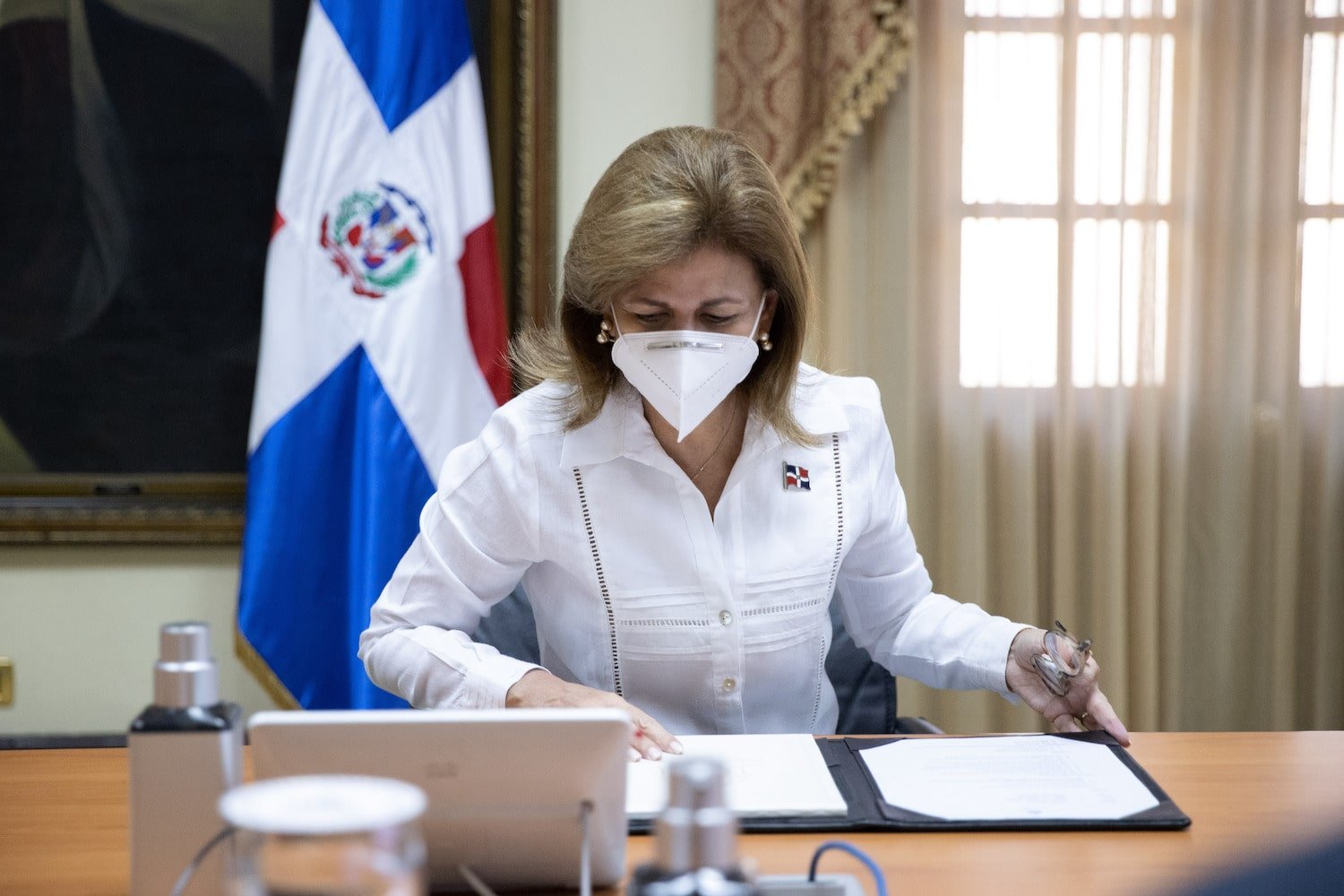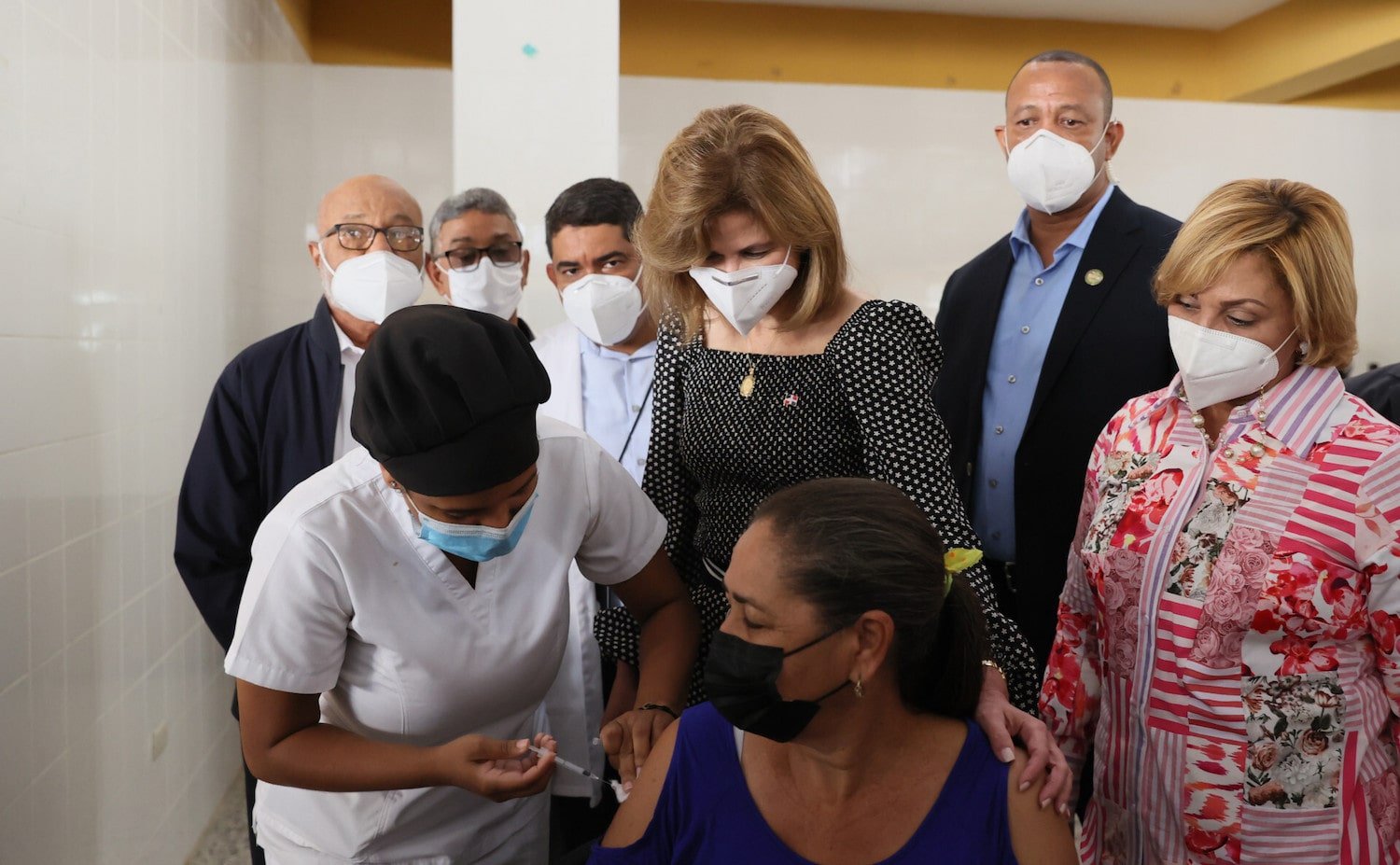Vice President of the Dominican Republic Raquel Peña recently announced that the country has reached 5 million citizens who have received two doses of the COVID-19 vaccine — gradually approaching the goal of vaccinating 70% of the population to reach herd immunity.
Known for its early economic recovery during the pandemic, the Dominican Republic also announced a record number of tourists during the month of September, and it remains the lowest-risk destination in the Caribbean.
Peña, who has dedicated her life to business and academia, has been in charge of managing the coordination of the Health Cabinet during the COVID-19 pandemic, achieving one of the highest vaccination rates in the region and an economic reactivation that takes into account the needs of the new traveler profile in a post-pandemic era.
In an exclusive interview with Global Citizen, Peña gives details about how the pandemic has affected the country and what has been key to initiating an economic recovery, achieving a high vaccination rate, and maintaining a safe tourism destination.

Global Citizen: How has the COVID-19 pandemic affected the Dominican Republic and what have the challenges been?
Vice President Raquel Peña: As a country, the Dominican Republic has not been exempt from the effects that the COVID-19 pandemic has produced worldwide — effects of great significance that permeated our people and our economy in all dimensions of life — and which brought to light pending tasks on inequality, the digital divide, and social protection, [as well as] opportunities to generate greater resilience in productive sectors. We are facing an unprecedented situation, where social, economic, and political actors relied on the actions of the State. Undoubtedly, this is a test for a new management model, a test for governance and for our leadership, but it is also an opportunity to strengthen the social fabric and international articulation.
Faced with an uncertain horizon, due to the degree of lack of knowledge about the coronavirus, we were committed from the start to strengthening digital government tools, to guaranteeing education, production chains, food safety, and above all the integrity of the health system. [We did] all this in order to continue offering the services that we are called to provide, beyond COVID-19, and [to] guarantee effective care, despite the systemic gaps that the sector suffered. However, the confidence shown by all sectors encouraged us not to give up in the face of this enormous challenge, which has allowed our country to be 84% below the average in Latin America in the total number of coronavirus cases per million [in the] population. The number of deaths from the disease is 82% lower than the average for Latin America, placing us as one of the countries with the lowest fatality in the region.
Currently, the positivity rate remains low at less than 6%, and the fatality rate close to 1%. This has been possible thanks to adequate strategic planning that identified the regulatory, institutional, and market aspects that had to be addressed, which did not prevent the timely supply of the necessary resources, despite the limitations of the international market. All these challenges did not prevent the country from obtaining the supplies needed for the implementation of the very successful National Vaccination Plan, which places the Dominican Republic as a model in the region.
¡Más de 13 millones de dosis han sido aplicadas!
— Raquel Peña (@RaquelPenaVice) October 23, 2021
La meta está cada vez más cerca, solamente juntos lograremos el 70% de vacunados a nivel nacional.
Si todavía no te has aplicado la primera, segunda o tercera dosis, hoy es un buen día para hacerlo.#VacúnateRD
What are the results of the vaccination plan so far, and how has the wider population reacted to it? And how has it helped bring different age groups closer to the vaccine?
We can affirm that the National Vaccination Plan against COVID-19 is the largest and most important public-private alliance that the Dominican Republic has had. Together with the private sector, academia, and trade union and civil society organizations, we were able to launch an effective and inclusive campaign. We were able to successfully overcome the challenges involved in accessing the amount of doses necessary to inoculate all of our people, to keep our health system stable, our economy afloat, and to be firm in the sanitary measures that the pandemic demands.
Initial vaccine dose limitations led us to use data analysis and engineering tools as well as agile logistics design and deployment with the aim of urgently protecting the population at greatest risk. [We did] all this while the negotiation efforts with the pharmaceutical companies were redoubled, in order to have a greater number of doses to reach the entire population, in an environment of accentuated social protection and care economy. Industries and universities in the country were integrated [into the plans] to provide the supplies that were needed in the hospitals, innovating in the production of these, so we would be able to face shortages in the international markets. In just six months, we have vaccinated more than 60% of the adult population, and 100% of our health personnel. At its highest moment, the Dominican Republic was the second country in Latin America with the highest rate of new daily vaccinations per 100 citizens.
We have been able to begin to reduce some restrictions, given the downward trend shown in infections by the virus, and pay attention to the reactivation of economic activity, with an openness that has made possible the recovery of various productive sectors in the country. An example of this is the elimination of the curfew in the provinces where 70% of the population has both doses of vaccine against COVID-19. In parallel, the National Vaccination Plan has been complemented with access to free laboratory tests to detect the virus, which allows us to strengthen our containment strategy. The National Vaccination Plan was structured so that the age groups with the highest risk, such as people over 65 years of age and health personnel, could receive the vaccines in the first stage of the plan.
Given the number of people with higher risks, we intensified negotiations to be able to obtain a greater quantity of vaccines so that everyone could be inoculated. Thanks to the efforts of the central government, we were able to expand mass vaccination for all age groups in less time than expected.
Part of the success of the National Vaccination Plan could be measured in the sense of ownership by all sectors. This has facilitated the implementation of versatile strategies and tactics that have been adapted at each stage of the plan. In this way, it has been possible to guarantee vaccines to the entire population, through different region specific campaigns. House-to-house vaccination has been carried out, while schools, shopping malls, recreation centers, sports centers, and churches, among others, have also been used as vaccination centers. Likewise, for the installation of vaccination centers, alliances with the private sector were established, allowing for accelerating vaccination and consequently economic reactivation. These efforts and alliances have allowed us to deploy more than 1,300 vaccination centers nationwide and, above all, we have integrated all sectors, who have made this goal their own and have been key to together overcoming this pandemic.
With the results obtained from the vaccination efforts, a de-escalation and economic reactivation plan was established, which has led the country to levels of activity and employment that are close to pre-pandemic levels. In addition, the Dominican Republic is ranked with a notable and historical advance in digital government, according to the E-Government Development Index. We will continue with the recovery and with the strengthening of the institutional systems that allow us to build further development. We will leave behind us an institutional structure with strong capacities to improve the anticipation models and the systemic response to future crises.
Equitable access to COVID-19 vaccines for everyone, as well as the offshoring of their production and a temporary lifting of intellectual property restrictions, are fundamental to achieve immunization of the global population. How does the Dominican Republic support these efforts?
As a right of all people, since we assumed the management of the Health Cabinet, we quickly proceeded [with] independent and direct negotiations with governments and different pharmaceutical companies, for the accelerated acquisition of the necessary amount of vaccines to inoculate 100% of the target population. In addition, the Dominican Republic is one of the 190 countries that are part of COVAX, a mechanism that allows equitable access to vaccines against COVID-19 worldwide. Beyond this, we understand that the measures that allow greater production and facilitation of access to the vaccine by all countries that have not been able to advance in vaccination are of great importance.
The Dominican Republic relaxed regulatory barriers to facilitate access to vaccines. We believe in the exchange of knowledge and technology transfers to broaden the production horizon, both for precursors and biological components. In this way, we respond to a virus that knows no barriers, with a vaccine distribution which can break down the barriers created by the virus, and with a universal commitment to public health.
Tourism is one of the main sources of income for the Dominican Republic. How will the implementation of a new recovery plan for the rehabilitation of the sector be sustainable, including environmental protection and climate action?
All the actions that we have taken at a general level to mitigate the effects of COVID-19 in our country have had a direct impact on tourism and with it, the progressive recovery of the livelihood of the thousands of workers who work in this sector, with a vision of community responsibility that prioritizes collective health and economic growth. Thanks to the right management and prevention and mitigation measures, the country has been able to recover tourism to the point of achieving the arrival of more than 2.5 million tourists, from January to August 2021, surpassing the figures for this same period for 2020.
The vaccination of workers in the tourism sector; the application of strict, specialized protocols for the sector; [and] the implementation of controls at airports and measures in tourist areas have allowed us to be a safe country for visitors. The implementation of the travel assistance plan, with COVID-19 coverage, has also been an effort for the safety of tourists who visit our beautiful country.

What have been your main motivations as a woman and vice president to successfully manage and cope with the challenges presented by the pandemic?
Since I started as Vice President of the Republic, President Luis Abinader entrusted me with the great responsibility of coordinating the Health Cabinet, in the midst of a health crisis. As a public servant, I understood that the health and lives of our people depended on proper management and we could not fail the hopes of a country. We had to successfully overcome the difficulties of a pandemic.
As a woman, I am proud to be able to put at the disposal of my country the spirit of the Dominican woman, who gives herself thoroughly to the tasks that she undertakes and who with strength contributes to her nation, from whatever position she may find herself in. The pandemic does not know gender, so both men and women have been affected by its aftermath. For everyone in an equal way, we will continue to apply policies of access to health, for as long as this health situation lasts and for as long as we have the privilege of serving the nation.
This interview has been translated from Spanish into English, and has been lightly edited for clarity.